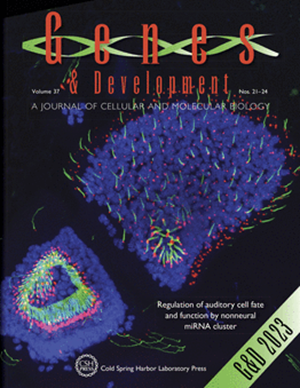Epigenetic priming of neural progenitors by Notch enhances Sonic hedgehog signaling and establishes gliogenic competence
IF 7.7
1区 生物学
Q1 CELL BIOLOGY
引用次数: 0
Abstract
The remarkable cell diversity of multicellular organisms relies on the ability of multipotent progenitor cells to generate distinct cell types at the right times and locations during embryogenesis. A key question is how progenitors establish competence to respond to the different environmental signals required to produce specific cell types at critical developmental time points. We addressed this in the mouse developing forebrain, where neural progenitor cells must switch from producing neurons to making oligodendrocytes in response to increased Sonic hedgehog (SHH) signaling during late embryogenesis. We show that progenitor responses to SHH are regulated by Notch signaling, thus permitting proper timing of the neuron–oligodendrocyte switch. Notch activity epigenetically primes genes associated with the oligodendrocyte lineage and SHH pathway, enabling amplified transcriptional responses to endogenous SHH and robust oligodendrogenesis. These results reveal a critical role for Notch in facilitating progenitor competence states and influencing cell fate transitions at the epigenetic level.Notch的表观遗传启动神经祖细胞增强Sonic hedgehog信号传导并建立胶质细胞生成能力
多细胞生物显著的细胞多样性依赖于多能祖细胞在胚胎发生过程中正确的时间和位置产生不同细胞类型的能力。一个关键的问题是祖细胞如何建立能力,以响应不同的环境信号,在关键的发育时间点产生特定的细胞类型。我们在发育中的小鼠前脑中解决了这一问题,在胚胎发育后期,神经祖细胞必须从产生神经元转向产生少突胶质细胞,以响应Sonic hedgehog (SHH)信号的增加。我们发现祖细胞对SHH的反应受到Notch信号的调节,从而允许适当的神经元-少突胶质细胞开关时间。Notch活性在表观遗传学上启动了与少突胶质细胞谱系和SHH通路相关的基因,从而放大了对内源性SHH的转录反应和强大的少突胶质形成。这些结果揭示了Notch在促进祖细胞能力状态和影响细胞命运转变的表观遗传水平上的关键作用。
本文章由计算机程序翻译,如有差异,请以英文原文为准。
求助全文
约1分钟内获得全文
求助全文
来源期刊

Genes & development
生物-发育生物学
CiteScore
17.50
自引率
1.90%
发文量
71
审稿时长
3-6 weeks
期刊介绍:
Genes & Development is a research journal published in association with The Genetics Society. It publishes high-quality research papers in the areas of molecular biology, molecular genetics, and related fields. The journal features various research formats including Research papers, short Research Communications, and Resource/Methodology papers.
Genes & Development has gained recognition and is considered as one of the Top Five Research Journals in the field of Molecular Biology and Genetics. It has an impressive Impact Factor of 12.89. The journal is ranked #2 among Developmental Biology research journals, #5 in Genetics and Heredity, and is among the Top 20 in Cell Biology (according to ISI Journal Citation Reports®, 2021).
 求助内容:
求助内容: 应助结果提醒方式:
应助结果提醒方式:


